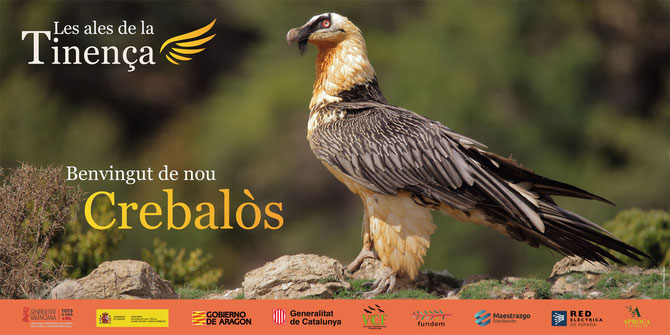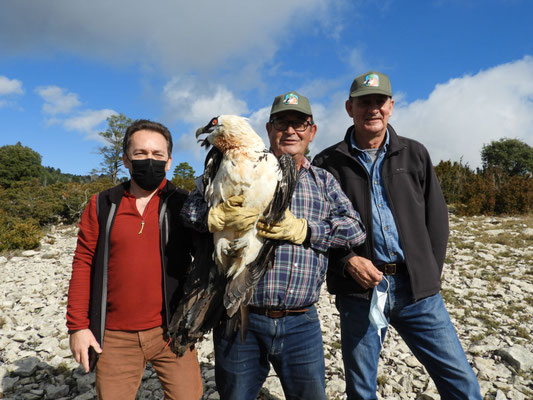
As part of the efforts to reintroduce the Bearded Vulture in Maestrazgo, also locally known as crebalòs, the project team released yet another Bearded Vulture from the Pyrenees to Parque Natural de la Tinença de Benifassà!
Latest Bearded Vulture release in Maestrazgo
Peraire, an adult bird from the Huesca Pyrenees, is the latest Bearded Vulture released in Parque Natural de la Tinença de Benifassà! On Wednesday, 11 November 2020, the project team released the bird to the Park, which is north of Castellón, bringing the total number of released Bearded Vultures to ten, however, one of the released birds died this year. Just like the other individuals released in the area, Peraire was equipped with a GPS tag on its back to monitor its movements and study its behaviour.
How the project releases birds
The project uses two techniques to release Bearded Vulture in Maestrazgo in an effort to bring back the species to the region.
In the end of spring and beginning of summer, captive-bred Bearded Vultures that originated from the VCF coordinated Captive Breeding Network are released in the wild through the hacking method. This entails placing chicks in artificial nests to acclimatize to the wild until they fledge, with food provided by the team without any human contact. In this way, the chicks recognize the area as their hatching place, in this case, Tinença de Benifassà, increasing the likelihood that they will return once they have reached breeding age and hopefully start to reproduce. However, the species does not reproduce until it reaches around 8-10 years old with only one chick surviving every breeding season if successful. Hence, such reintroduction projects take a long time to complete.
Furthermore, the project translocates and releases non-breeding Bearded Vulture adults from the Pyrenees that are loaned by the Government of Aragon. This strategy aims to accelerate reproduction if these specimens choose to remain in Tinença to breed.
Meet the Bearded Vultures released to Tinença
Since the start of the project in 2018, six captive-bred chicks originating from the VCF coordinated Bearded Vulture Captive Breeding Network have been introduced to the Tinença using the hacking method. Furthermore, with the latest release of Peraire, a total of four adults from the Pyrenees were translocated to the region.
Now, a few Barded Vultures can be seen flying over the sky of the Tinença and in the Maestrazgo, where four specimens are currently present: the young Amic, Bassi and Celest and the adult Otal.
In the table below, you can find out more about the released vultures.

Connecting populations of Bearded Vultures in Spain

The Maestrazgo region of Spain was historically a breeding site for Bearded Vultures and while there are no resident population the area is regularly visited by individuals released in Andalusia. The project to reintroduce the species to the region began in 2018 with the aim of establishing a wild breeding population that will bridge the populations in the Pyrenees and Andalusia, similar to the LIFE GYPCONNECT project in France that connects populations in the Pyrenees and the Alps. Over the course of the project captive-bred birds will be released in specially constructed hacking sites in the Parque Natural de la Tinença de Benifassà and in a unique experiment the team, in close consultation and collaboration with us here at the Vulture Conservation Foundation, will translocate adult non-breeding or floater birds from the population in the Pyrenees to the Maestrazgo region to test how effective this method is and if that has an effect on the reproductive productivity of the Pyrenean population. As part of the project the released birds will be monitored by fitting them with GPS transmitters to better understand how the move around the region and to encourage movements of birds to the region a series of supplementary feeding stations will be created.
The project is led by the Generalitat of Valencia, in collaboration with the Autonomous Communities from Aragón and Catalonia, the Spanish Ministry of Agriculture, Fish, Food and Environment and the us here at the Vulture Conservation Foundation.





